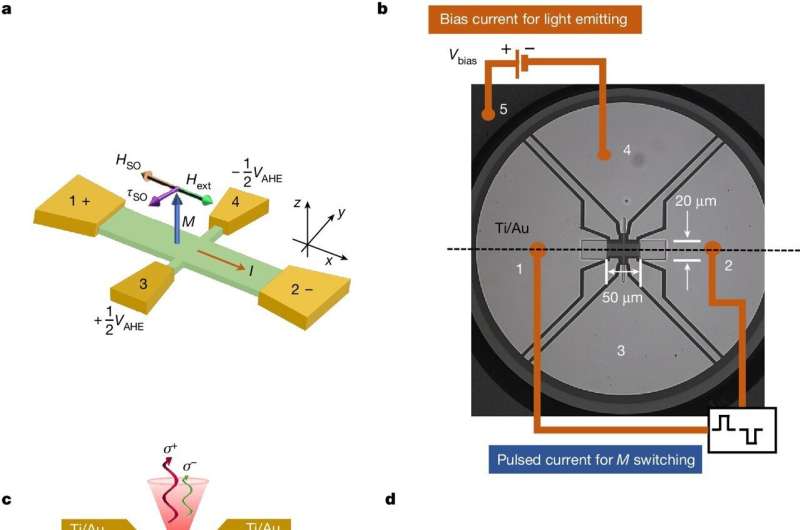This article has been reviewed according to Science X's editorial process and policies. Editors have highlighted the following attributes while ensuring the content's credibility:
fact-checked
peer-reviewed publication
trusted source
proofread
From Earth to Mars: Transporting spin information at the speed of light

Scientists have used electrical pulses to manipulate magnetic information into a polarized light signal, a discovery that could revolutionize long-distance optical telecommunications, including between Earth and Mars.
The breakthrough, described in a study published in Nature, involves the field of spintronics, which aims to manipulate the spin of electrons in order to store and process information.
The researchers applied an electrical pulse to transfer this spin information from electrons to photons, the particles that make up light, allowing the information to be carried great distances at great speed. Their method meets three crucial criteria—operation at room temperature, no need of magnetic field and the ability for electrical control—and opens the door to a range of applications, including ultrafast communication and quantum technologies.
"For decades we were dreaming of and predicting room-temperature spintronic devices beyond magnetoresistance and just storing information. With this team's discovery, our dreams become reality," says the study's co-author, Igor Žutić, SUNY Distinguished Professor of physics at the University at Buffalo.
The study was led by the Jean Lamour Institute, a joint unit of France's National Center for Scientific Research (CNRS) and the University of Lorraine. Other contributors represent universities and institutes in France, Germany, Japan, China and the United States.
Spintronic devices could replace conventional electronics
In spintronics, which has been used successfully in magnetic computer hard drives, information is represented by electron spin and, by its proxy, the direction of magnetization.
Ferromagnets, such as iron or cobalt, have an unequal number of electrons whose spins are oriented either along or against the magnetization axis. Electrons with spin along the magnetization travel smoothly across a ferromagnet, while those with opposite spin orientation are bounced around. This represents binary information, 0 and 1.
The resulting change of the resistance is the key principle for spintronic devices, whose magnetic state, which can be considered as stored information, is maintained indefinitely. Just as a fridge magnet does not need power to remain stuck to the door, spintronic devices would require much less power than conventional electronics.
However, akin to taking a fish out of water, spin information is quickly lost and cannot travel far when electrons are taken out of the ferromagnet. This major limitation can be overcome by utilizing light through its circular polarization, also known as helicity, as another spin carrier.
Just as humans centuries ago used carrier pigeons to transport written communication farther and faster than could be done on foot, the trick would be to transfer electron spin to photos, the quantum of light.
Spin-LEDs meet three criteria
The presence of spin-orbit coupling, which is also responsible for the spin information loss outside of the ferromagnet, makes such transfer possible. The crucial missing link is then to electrically modulate the magnetization and thereby change the helicity of the emitted light.
"The concept of spin-LEDs was initially proposed at the end of the last century. However, for the transition into a practical application, it must meet three crucial criteria: operation at room temperature, no need of magnetic field, and the ability for electrical control," says the study's corresponding author, Yuan Lu, senior CNRS researcher at the Jean Lamour Institute.
"After more than 15 years of dedicated work in this field, our collaborative team has successfully conquered all obstacles."
The researchers successfully switched the magnetization of a spin injector by an electrical pulse using the spin-orbit torque. The electron's spin is rapidly converted into information contained in the helicity of the emitted photons, enabling a seamless integration of magnetization dynamics with photonic technologies.
This electrically controlled spin-photon conversion is now achieved in the electroluminescence of light-emitting diodes. In the future, through the implementation in semiconductor laser diodes, so-called spin-lasers, this highly-efficient information encoding could pave the way for rapid communication over interplanetary distances since polarization of light can be conserved in space propagation, potentially making it the fastest mode of communication between Earth and Mars.
It will also greatly benefit the development of various advanced technologies on Earth, such as optical quantum communication and computation, neuromorphic computing for artificial intelligence, ultrafast and highly-efficient optical transmitters for data centers or Light-Fidelity (LiFi) applications.
"The realization of spin-orbit-torque spin injectors is a decisive step that will greatly advance the development of ultrafast and energy-efficient spin-lasers for the next generation of optical communication and quantum technologies," says co-author Nils Gerhardt, professor at the Chair of Photonics and Terahertz Technology at the Ruhr University in Bochum.
More information: Pambiang Abel Dainone et al, Controlling the helicity of light by electrical magnetization switching, Nature (2024). DOI: 10.1038/s41586-024-07125-5
Journal information: Nature
Provided by University at Buffalo




















